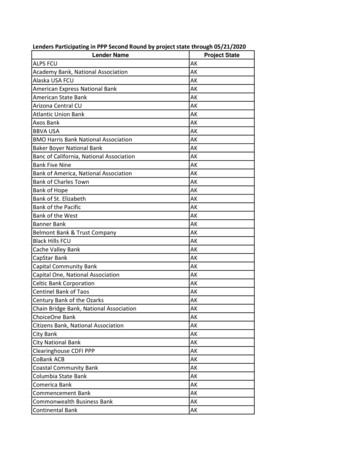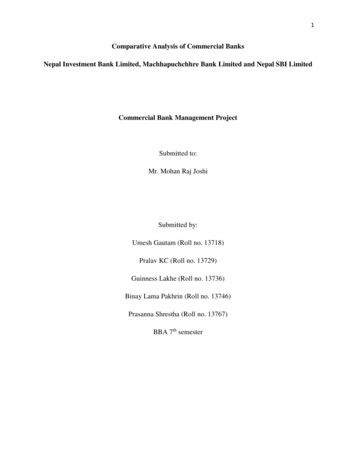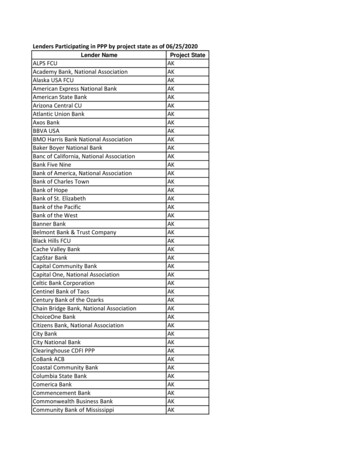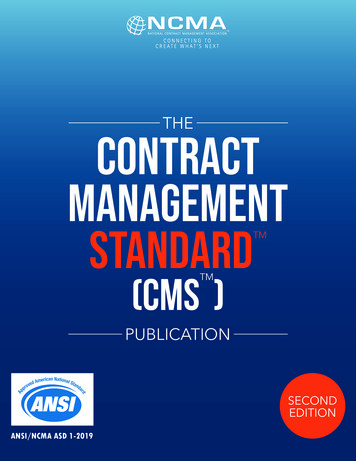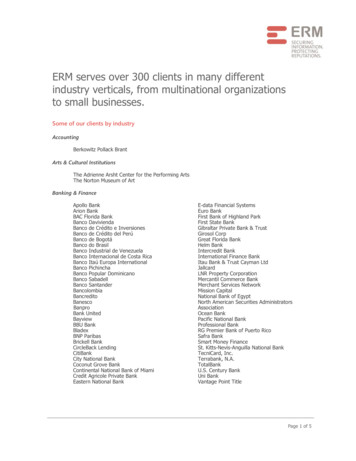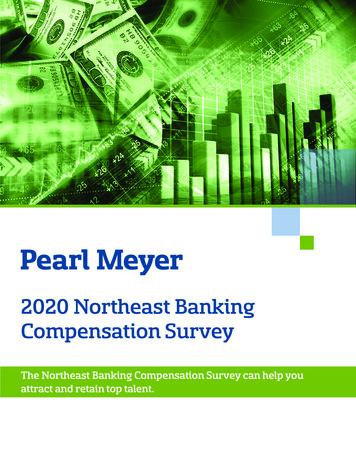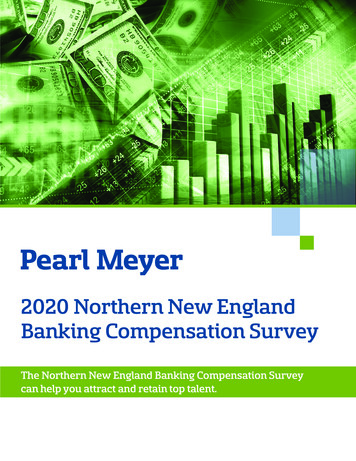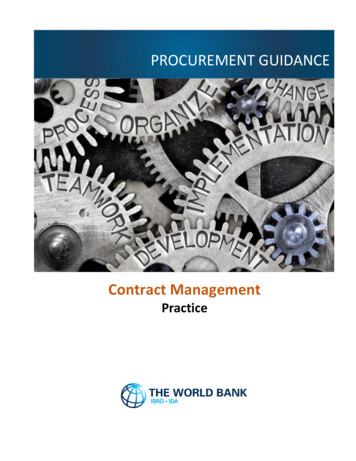
Transcription
Contract Management GuidancePROCUREMENTGUIDANCEApril 2018Contract ManagementPractice
Published September 2018 – First EditionCopyright 2018The World Bank1818 H Street NWWashington DC 20433Telephone: 202-473-1000Internet: www.worldbank.orgDisclaimerThis work is a product of the staff of The World Bank. The findings, interpretations, andconclusions expressed in this work do not necessarily reflect the views of The World Bank, itsBoard of Executive Directors, or the governments they represent.Rights and PermissionsThe material in this work is subject to copyright. Because The World Bank encouragesdissemination of its knowledge, this work may be reproduced, in whole or in part, fornoncommercial purposes as long as full attribution to this work is given. Any queries on rightsand licenses, including subsidiary rights, should be addressed to:Office of the PublisherThe World Bank1818 H Street NWWashington, DC 20433USAFax: 202-522-2422Email: pubrights@worldbank.org
Common abbreviations and defined termsThis section explains the common abbreviations and defined terms that are used in this User’s Guide.Defined terms are written using capital letters.Abbreviation / termFull terminology / definitionBankThe World Bank. IBRD and/or IDA (whether acting on its ownaccount or in its capacity as administrator of trust funds providedby other donors).BidAn offer, by a firm or joint venture, in response to a Request forBids to provide the required Goods, Works or Non-consultingServices.BidderA firm or joint venture that submits a Bid for Goods, Works, orNon-consulting Services in response to a Request for Bids. Toimprove readability, the terms “Bid” and “Bidder” are throughoutthis guidance written as “bid” and “bidder” respectively.BorrowerA Borrower or recipient of Investment Project Financing (IPF) andany other entity involved in the implementation of a projectfinanced by IPF. In the context of this guidance, this may includerelevant entities such as a Purchaser, an Employer and Client. Insome contexts of the guidance, such as for Goods (incoterms,letter of credit etc.) or information systems contracts, for betterclarity, the term “Purchaser” is itself used.CMPContract Management Plan.ConsultantA variety of private and public entities, joint ventures, orindividuals that provide services of an advisory or professionalnature. To improve readability, the term “Consultant” isthroughout this guidance written as “consultant”.Consulting ServicesCovers a range of services that are of an advisory or professionalnature and are provided by Consultants.These Services typically involve providing expert or strategicadvice e.g. management consultants, policy consultants orcommunications consultants. Advisory and project relatedConsulting Services include, for example: feasibility studies,project management, engineering services, finance andaccounting services, training and development.ContractExcept when used with defined terms such as Contract Managerand Contract Management Plan, the term “Contract” isthroughout this guidance written as “contract.” Given the
Abbreviation / termFull terminology / definitionmultiplicity of times that this term appears in this guidance, thisapproach improves readability.Contract ManagerFor the purpose of this guidance, “Contract Manager” is a genericterm used to refer to a legal entity, a natural person/teamassigned to/ authority vested on/ delegated to manage theexecution of a contract. Depending on the applicable contractform, “Contract Manager” may refer to: a range of contract management arrangements such asthe:o “Engineer” in FIDIC: Conditions of Contract forConstruction or Conditions of Contract for Plant&Design build;o “Employer’s Representative” in FIDIC: Conditionsof Contract for EPC/Turnkey;o “Project Manager”, for example, in Bank’s SPDsfor Small Works; orthe Borrower’s internal team when assigned to manage acontract.In generic contexts, and in contexts which require reference tothe Borrower such as in managing the Contract Manager(Engineer, Project Manager etc.), the term “Borrower” is used.ContractorThe entity named in the respective contracts to execute acontract for Goods, Works or Non-Consulting Services. Toimprove readability, the term “Contractor” and “Sub-contractor”are throughout this guidance written as “contractor” and “subcontractor” respectively. In some contexts, such as related toGoods contracts, the term “supplier” is also used in place of“contractor.”CPMCritical Path Method.D&BDesign and Build.DBBDesign, Bid, Build.DBODesign, Build, Operate.EmployerThe entity named as such in the respective contract e.g.procurement of Works or Plant based on Bank’s SPDs.Environmental and SocialCommitment PlanAs described in the Bank’s Environmental and Social Framework.EPCEngineering, Procurement and Construction.
Abbreviation / termFull terminology / definitionESHSEnvironmental, Social, Health and Safety.FIDICFédération Internationale des Ingénieurs-Conseils-theinternational federation of consulting engineers.Fraud and CorruptionThe sanctionable practices of corruption, fraud, collusion,coercion and obstruction defined in the Anti-CorruptionGuidelines and reflected in paragraph 2.2a of Annex IV of theProcurement Regulations.GBVGender Based Violence.GCCGeneral Conditions of Contract.GoodsA category of Procurement that includes: commodities, rawmaterial, machinery, equipment, vehicles, Plant, and relatedservices such as transportation, insurance, installation,commissioning, training, and initial maintenance.Investment Project Financing(IPF)The Bank’s financing of investment projects that aims to promotepoverty reduction and sustainable development. IPF supportsprojects with defined development objectives, activities, andresults, and disburses the proceeds of Bank financing againstspecific eligible expenditures.Non-consulting ServicesServices which are not Consulting Services. Non-consultingServices are normally bid and contracted on the basis ofperformance of measurable outputs, and for which performancestandards can be clearly identified and consistently applied.Examples include: drilling, aerial photography, satellite imagery,mapping, and similar operations.PlantThe provision of equipped facilities, such as those executed onthe basis of design, supply, installation and commissioning.ProcurementThe function of planning for, and sourcing Goods, Works, Nonconsulting Services, and/or Consulting Services to meet requiredobjectives.Procurement DocumentsA generic term used in the Procurement Regulations to cover allProcurement Documents issued by the Borrower. It includes:GPN, SPN, EOI, REOI, Prequalification document, Initial Selectiondocument, RFB and RFP, including any addenda.Procurement ProcessThe process that starts with the identification of a need andcontinues through planning, preparation of specifications/requirements, budget considerations, selection, contract award,
Abbreviation / termFull terminology / definitionand contract management. It ends on the last day of the warrantyperiod.Project Procurement Strategyfor Development (PPSD)A project-level strategy document, prepared by the Borrower,that describes how Procurement in IPF operations will supportthe development objectives of the project and deliver VfM.ProposalAn offer, in response to a request for proposals, which may ormay not include price, by one party to provide Goods, Works,Non-consulting Services or Consulting Services to another party.To improve readability, the term “Proposal” is throughout thisguidance written as “proposal”.ProposerAn individual entity or joint venture that submits a Proposal forGoods, Works, and Non-consulting Services in response to arequest for proposals. To improve readability, the term“Proposer” is throughout this guidance written as “proposer”.PurchaserThe entity named as such in the respective contract e.g.procurement of Goods or information systems based on Bank’sSPDs.SEASexual Exploitation and Abuse.Standard ProcurementDocuments (SPDs)Procurement Documents issued by the Bank to be used byBorrowers for IPF financed projects. These include, GPN, SPN,EOI, REOI, Prequalification document, Initial Selectiondocuments, RFB and RFP documents.SubconsultantAn entity to whom/which the Consultant subcontracts part of theConsulting Services while remaining solely liable for the executionof the Contract. “Subconsultant” is written as “subconsultant” inthis guidance.Sub-contractorAn entity to whom/which the Contractor subcontracts part of theWorks while remaining solely liable for the execution of theContract. “Sub-contractor” is written as “sub-contractor” in thisguidance.TORTerms of Reference (usually referencing a Consulting Servicescontract).VEValue Engineering.VfMValue for Money.WorksA category of Procurement that refers to construction, repair,rehabilitation, demolition, restoration, maintenance of civil work
Abbreviation / termFull terminology / definitionstructures, and related services such as transportation, insurance,installation, commissioning, and training.
ContentsIntroduction. 1Preamble .1Purpose .1Scope .1Structure of the guidance .1Contract management in Procurement Regulations .2The fundamentals . 4Upstream and downstream phases of a contract .4Contract management objectives .5Plan, do, check .5Role of Contract Manager .6Hard and soft skills.6Teamwork .8Governance and management .8In-house vs. outsourcing .9Potential pitfalls . 10Different Fit-for-purpose contract management . 15Proportional . 15Supply positioning . 15Managing relationships . 17Successful relationship management . 17Plan and act early . 18Relationship mapping. 19Preparing a Contract Management Plan . 22Why plan . 22When to plan . 22How to plan . 22Contract start-up . 24Transition . 24Facilitating contract start-up . 24Some bottlenecks affecting contract start-up . 26Contract Implementation: Managing time, cost, quality and risk . 28Three-dimensional approach . 28Time control . 28Cost control . 29
Quality control. 35Managing Contract risks . 35Managing contract change . 37The need for change . 37Change management procedures . 37Bank sanctioned firms or individuals. 38Managing value engineering . 39Definition . 39Benefits . 39VE at the design stage . 40VE during contract implementation . 40Submitting a VE proposal . 41Managing contractual disputes . 42Contract disputes . 42Dispute management . 42Contractual remedies . 44Contractual remedies . 44Fraud and corruption . 47Special considerations: Works and Plant contracts . 49Project management software . 49Delays due to the Borrower . 50Variations . 51Site visits . 51Contract Manager’s documents . 52Design and build contracts . 53Contractor’s claims in construction contracts . 55Construction contracts Taking-over . 59Defect Liability Period . 60Special considerations: Managing ESHS Risks in Works Contracts . 61Background . 61Relationships and responsibilities . 61Overview of the Roles . 61Contractor mobilization/contract initiation . 63Contract implementation . 65Contract Taking-over ESHS aspects . 68Defect liability Period-ESHS aspects . 68Special considerations: Goods contracts. 70Supply chain management . 70
Incoterms . 71Export restrictions . 72Delay in L/C processing . 72Special considerations: Information Systems contracts . 73Software license agreements . 73Source code . 73Specialist project manager . 74Systems requirements . 75Quality of product . 76Upgrades and discontinued products . 77Transfer of knowledge . 78Value engineering . 79Special considerations: Consulting Services contracts . 81Supervision . 81Contract management . 81Kick-off meeting. 82Non-compliant deliverables . 82Unsatisfactory performance . 82Approving payments . 83Time control . 83Key risks . 83Annex 1: World Bank contracting modalities . 85Annex 2: Measuring performance . 89Annex 3: SAMPLE TEMPLATE - Contract Management Plan . 92Annex 4: SAMPLE TEMPLATE - Contract Mobilization . 102Annex 5: SAMPLE TEMPLATE - Contracts Inventory Listing . 105
Contract Management PracticeIntroductionIntroductionPreambleProject implementation under Investment Project financing (IPF) normally includes procurement activitiesneeded to attain the project development objectives. The Borrower should be mindful that the precontract award processes (such as comprehensiveness of project documents, proper planning, choice ofcontract, appropriateness and quality of Procurement Documents, evaluation of bids/proposals etc.) allcontribute to the success of a contract. The Bank has other guidance in place to support Borrowers in thepre-contract award processes.Procurement, including contract management, is a critical component of budgetimplementation/execution – as defined within the public financial management cycle. Financial controlsshould be in place to ensure that funds are available in a timely manner and are used only for the intendedpurposes. If there are issues in the budget planning and approval process, such issues should be identifiedwell in advance (e.g. during Project preparation) and appropriate arrangements put in place. Undue delaysin making contractual payments puts the Borrower at contractual default, potentially also affectingcontractor cash flow, resulting in contract implementation delays and other complications.Effective contract management is essential to the delivery of the intended outcomes. This guidance assistsBorrowers in managing contracts (post- contract award) under IPF operations.PurposeThe purpose of this guidance on Contract Management: Practice (guidance) is to support Borrowers’contract management practice by illustrating some of the key aspects and issues. It should be kept in mindthat contracts shall be managed in accordance with the contract.ScopeContract management is part of the Procurement Process. The processes preceding contract award (suchas procurement planning, selection of contractors etc.) are described in detail in the various procurementguidance.This guidance focuses on the contract management activities undertaken during the period from theaward of contract to contract completion. Where applicable, this period includes the defects liabilityperiod and/or warranty period.Structure of the guidanceThis guidance starts from the general and relevant aspects of contract management (such as ContractManagement Plan (CMP), relationship management etc.). It then presents the contract managementaspects of selected categories (such as Works, Goods etc.) to try to support teams involved in managingone or more of those categories. There is also a section on managing ESHS risks in Works contracts. Teams1
Contract Management Practicemanaging one or more of these categories may prefer to refer to the general provisions followed by thecategory/ies of interest.This guidance comprises of practical short case studies to illustrate relevant contract managementaspects. The guidance also comprises of some templates such as for CMP, which may be modified to suitthe needs of a contract.There is also a separate excel based Contract Price Adjustment Computation Workbook to supportBorrowers in applying contractual price adjustments.Contract management in Procurement RegulationsThe contract management requirements detailed in the Bank’s Procurement Regulations for IPFBorrowers (Procurement Regulations) set out the framework for contract management, as summarizedin the following table.SectionParaSection V.GeneralProcurementProvisions5.97Annex I.2.1TopicProvisionAim of contractmanagementThe aim of contract management is to ensure that allparties meet their obligations.In addition, contracts shall be actively managed by theBorrower throughout their life to ensure that contractorperformance is satisfactory, appropriate stakeholdersare informed and all contract requirements are met.Value formoneyValue for Money (VfM) is to be considered at all stagesof the Procurement Process, including during contractmanagement.2.3 h.EffectivecontractmanagementVfM is achieved through the application of effectivecontract management to ensure successful execution ofthe contract and ensure that the deliverables are met asagreed in the contract3.6ContractmanagementactivitiesAs part of the contract management activities, theBorrower determines the appropriate contract type andcontract terms, taking into account the nature, risk, andcomplexity of the activity, fit-for-purposeconsiderations, optimal allocation of risk and liabilities,and the roles and responsibilities of the contractingparties.3.7Requirementto develop aCMPTo effectively manage a contract, for contracts identifiedin the PPSD, the Borrower shall develop a ContractManagement Plan with key performance indicators andmilestone events. The Borrower shall monitor theperformance and progress of contracts, in accordancewith the Contract Management Plan, and provide timelyValue forMoney2
Contract Management PracticeSectionParaTopicProvisionreports to the Bank. The Bank may use the informationgathered to benchmark performance.Annex II.7.1 j.ProcurementOversightBank’s priorreviewStates that for contracts subject to prior review, ifrequested by the Bank, the Contract Management planincluding the KPIs will be subject to Bank’s prior review.Annex V.3.1PPSDProjectProcurementStrategy forDevelopmentThe Project Procurement Strategy for Development(PPSD) provides the basis for the Borrower to preparethe Procurement Plan and the Contract ManagementPlan.3.4resourcesThe factors to be considered for assessing the Borrowersresources needs to implement a procurement includecontract management capacity.3.8Risk mitigationplanThe likelihood and impact of each risk shall be assessed,and a prioritized Risk Mitigation Plan developed andmaintained throughout the life of the project, includingduring the contract management phase.3.11PPSD specifiesrequirementfor CMPThe PPSD will identify those contracts requiring aContract Management Plan.Content ofCMPThis Annex outlines the requirements for ContractManagement and for monitoring through the ContractManagement Plan (CMP).Annex XI.ContractManagementwholeAnnexAnnex XIV.2.1CMP and PPPPublic-PrivatePartnership(PPP)Contract management is one of the phases in PPParrangements.2.2ResourcesThe Borrower needs to demonstrate that there isadequate institutional capacity to prepare, structure,procure and manage the PPP project4.1RolesThe Borrower shall ensure that the output specificationsinclude how performance will be monitored, includingroles for the government’s contract management team.Table I – Contract management provisions in the Bank’s Procurement Regulations3
Contract Management PracticeThe fundamentalsThe fundamentalsUpstream and downstream phases of a contractContract management is the process of actively managing contract implementation to ensure the efficientand effective delivery of the contracted outputs and/or outcomes.Effective contract management enables Borrowers to maximize value for money (VfM) in deliveringdevelopment outcomes. The focus of contract management is on the activities that are undertaken duringthe contract execution/implementation phase, following the award of contract (downstream activities).However, the success of contract management is strongly influenced by upstream activities such as thoseundertaken during the procurement planning, choice of contract, and contractor selection phase.Figure I- Upstream and downstream phases of contractmanagement4
Contract Management PracticeContract management objectivesThe key objectives of contract management are to ensure that the contract is:1. delivered on time, at the right place and in the right quantity;2. completed to the required specifications, standards and/or quality;3. completed within the agreed price.Contract management continues throughout the life of the contract. This means that the Borrower needsto plan for, and undertake:1. effective and efficient management of performance, delivery and payment;2. methodical and measured change control;3. active risk mitigation and management;4. agile resolution of issues and disputes.Plan, do, checkGood project management involves planning how to manage the project, implementing the plan and thenchecking the results. Applying to contract management, these key steps are illustrated in Figure II.Figure II – contract management basics: plan, execute, check, evaluateTo achieve good contract performance, Borrowers should ensure that the terms of the contract areadhered to and that both parties to the contract understand their respective obligations. Contractmanagement also involves a level of flexibility by both parties and a willingness to adapt the contractterms to reflect any changing circumstances, as appropriate. Good contract management is strengthenedby systematic and efficient planning, execution, monitoring, and evaluation.5
Contract Management PracticeRole of Contract ManagerGood practice requires that a Contract Manager is appointed for every contract. For small, routinecontracts, this may be one person, who has a portfolio of contracts to manage. For large, complex, highvalue contracts this is normally an entity (Engineer, Project Manager etc.) The Contract Manager needs tohave the appropriate range of qualifications, skill mix and experience.A Contract Manager needs to multi-task, as for example, shown in Figure III.Figure III – Contract Manager responsibilitiesHard and soft skillsA Contract Manager requires an appropriate mix of hard or technical skills (e.g. financial management)and soft skills (e.g. interpersonal and relationship management). The relevant mix of skills depends on thenature and complexity of the contract, the levels of risk and the delivery/operating environment.Hard skills - technical skillsTypical technical skills, knowledge and experience required include:1. procurement;2. project management;3. legal knowledge (at the very least an ability to understand the legal aspects of the contract,including remedies);4. financial management;5. analytics and reporting;6. administrative, record keeping.Additional skills may be required because of the subject matter or complexity of the contract. It isessential to have access to sufficient skills and experience as and when required. For example:1. civil engineering, water engineering;6
Contract Management Practice2. environmental and/or social knowledge and skills;3. safety expertise;4. systems or IT skills for a software development project;5. medical expertise when purchasing medical diagnostic equipment.Soft skills – interpersonal skillsIn addition to technical (“hard skills”), a range of “soft skills” are required to build a successful relationshipwith relevant stakeholders, and to build successful contract management teams. Examples of relevantsoft skills include:1. leadership, motivation and team building;2. decision making;3. interpersonal, communication and relationship ma
Effective contract management is essential to the delivery of the intended outcomes. This guidance assists Borrowers in managing contracts (post- contract award) under IPF operations. Purpose The purpose of this guidance on Contract Management

